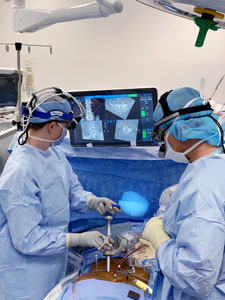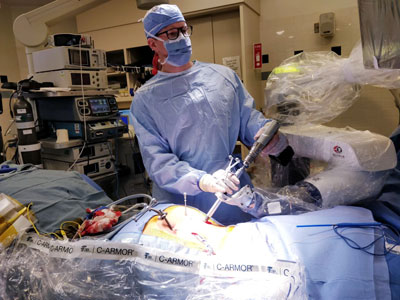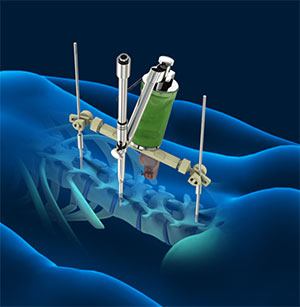1st Globus Robotic Spine Surgery in Dallas!
Dr. Donnally performing robotic navigated spine surgery
Robotic Spine Surgery: an inside look



What is Robotic Spine Surgery?
Robotic spine surgery is a procedure where your surgeon is assisted by a robotic system to perform surgery to the spine. Precision is very important when performing spine surgery. Robotic systems are becoming increasingly popular in the medical fraternity as it offers better precision and reduces the risk of complications associated with conventional surgery. Your doctor can use robotic assistance while performing an open or minimally invasive procedure.
A typical robotic system used for spine surgery consists of:
- Workstation with advanced software
- Mounting platform
- Guidance unit
Robotic spine surgery is carried out in 4 phases:
Preoperative planning
A preoperative CT scan is obtained and uploaded to the software on the workstation which helps create a 3D model of the patient’s spine with axial, lateral and AP views. Your doctor then creates a blueprint for the procedure choosing an appropriate implant size and strategy for placement. The software also helps your doctor identify possible anatomic challenges such as asymmetry and poorly formed vertebrae. The preoperative plan may be modified until your surgeon is satisfied.
Application of mounting platform
An appropriate mounting platform is chosen depending on the kind of surgery being performed. The platform is rigidly attached to your spine and helps with the accuracy of the procedure even with patient movement.
Syncing the preoperative plan with the mounting platform
Two fluoroscopic (live x-ray) images are obtained intraoperatively and anatomical locations on these images are correlated with those on your preoperative CT scan so that the mounting system and preoperative blueprint are well matched. The software registers each vertebra regardless of changes in the intervertebral space.
Operation
Once the sync is complete your surgeon is ready to operate. The operation begins by selecting a target vertebra. The guidance unit is attached to the mounting platform in a precise location as determined by the software. The guidance unit helps your doctor place instruments at a precise trajectory so that implants can be placed in the planned location with a high degree of accuracy. This same process is followed for all targeted vertebrae until the procedure is complete.
Advantages of Robotic Spine Surgery
Advantages of robotic spine surgery include:
- Detailed preoperative planning
- Accurate placement of instruments and implants
- Reduced risk of complications
- Reduced X-ray exposure
Robotic spine surgery is considered safe and effective but may not be appropriate for everyone. Always discuss with your doctor about all treatment options suitable for you, as well as the benefits and risks.












